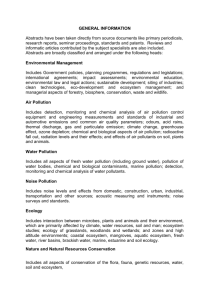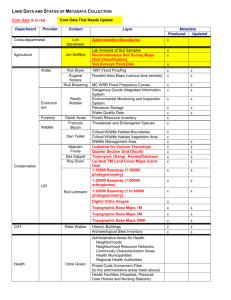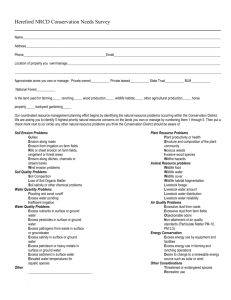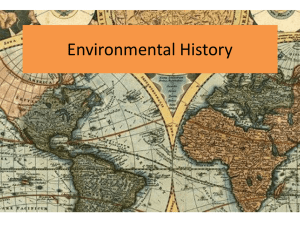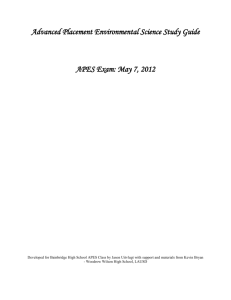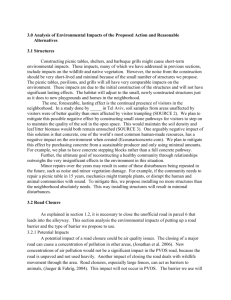Ag & Natural Resources
advertisement
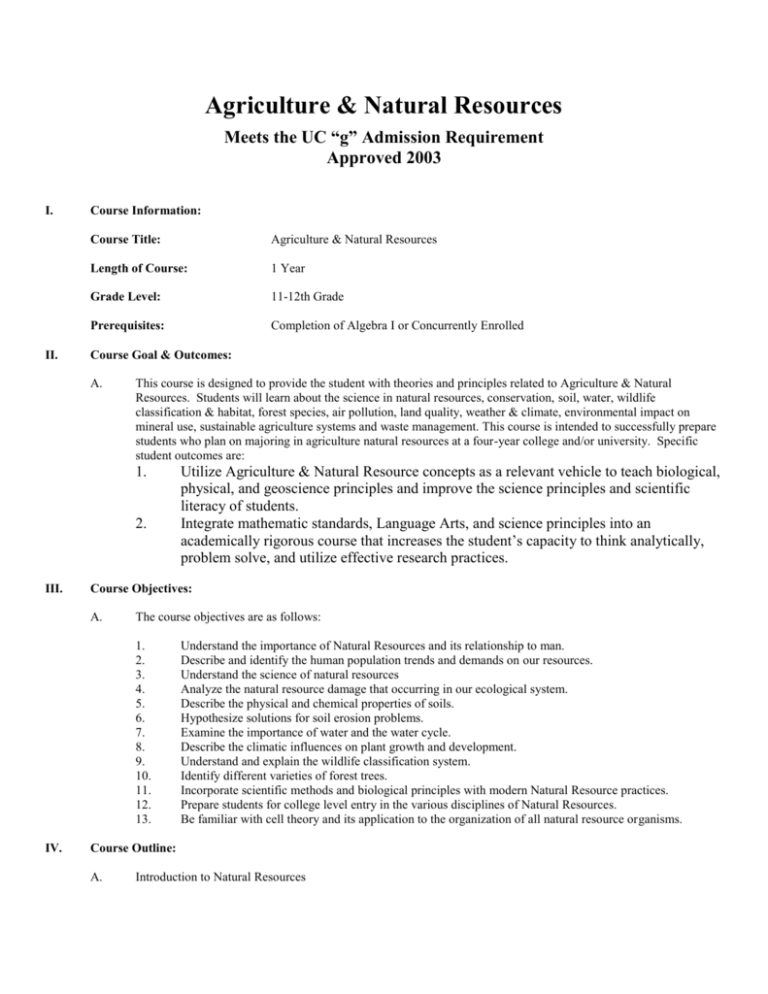
Agriculture & Natural Resources Meets the UC “g” Admission Requirement Approved 2003 I. II. Course Information: Course Title: Agriculture & Natural Resources Length of Course: 1 Year Grade Level: 11-12th Grade Prerequisites: Completion of Algebra I or Concurrently Enrolled Course Goal & Outcomes: A. This course is designed to provide the student with theories and principles related to Agriculture & Natural Resources. Students will learn about the science in natural resources, conservation, soil, water, wildlife classification & habitat, forest species, air pollution, land quality, weather & climate, environmental impact on mineral use, sustainable agriculture systems and waste management. This course is intended to successfully prepare students who plan on majoring in agriculture natural resources at a four-year college and/or university. Specific student outcomes are: 1. 2. III. Course Objectives: A. The course objectives are as follows: 1. 2. 3. 4. 5. 6. 7. 8. 9. 10. 11. 12. 13. IV. Utilize Agriculture & Natural Resource concepts as a relevant vehicle to teach biological, physical, and geoscience principles and improve the science principles and scientific literacy of students. Integrate mathematic standards, Language Arts, and science principles into an academically rigorous course that increases the student’s capacity to think analytically, problem solve, and utilize effective research practices. Understand the importance of Natural Resources and its relationship to man. Describe and identify the human population trends and demands on our resources. Understand the science of natural resources Analyze the natural resource damage that occurring in our ecological system. Describe the physical and chemical properties of soils. Hypothesize solutions for soil erosion problems. Examine the importance of water and the water cycle. Describe the climatic influences on plant growth and development. Understand and explain the wildlife classification system. Identify different varieties of forest trees. Incorporate scientific methods and biological principles with modern Natural Resource practices. Prepare students for college level entry in the various disciplines of Natural Resources. Be familiar with cell theory and its application to the organization of all natural resource organisms. Course Outline: A. Introduction to Natural Resources 1. 2. 3. B. Use of Natural Resources 1. 2. 3. 4. C. FOR REFERENCE ONLY Wildlife Classification Wildlife Animals Habitat Classification Wildlife Endangerment & Protection Practices Forests 1. 2. 3. 4. 5. I. The Importance of Water Water Composition and States The Water Cycle Watersheds & Wetlands Water Quality Factors Wildlife 1. 2. 3. 4. H. The Importance of Soil Soil Content & Formation Chemical & Physical Properties of Soil Soil Profiles Water and Natural Resources 1. 2. 3. 4. 5. G. The Importance of Conservation Natural Resource Damage & Pollution History of Natural Resource Conservation Soil - Renewable Natural Resource 1. 2. 3. 4. F. The Earth in its Solar System Spheres Ecology Succession Natural Resource Conservation 1. 2. 3. E. Human Population Trends & Demands Resource Supply & Population Urban and Rural Impacts to the Environment Resource Recycling & Reuse Science in Natural Resources 1. 2. 3. 4. D. Kinds of Natural Resources Renewability & Exhaustibility Conservation and Preservation Air Use of Forests Physical Structure of Forests Tree Species Names and Identification of Trees Forest Management 1. 2. 3. 4. J. Land Resources 1. 2. 3. 4. K. FOR REFERENCE ONLY Development of Agriculture & Natural Resources project Statistical management of project via Record Book Instructional coordination and supervision Analysis of project results Professional Opportunities in Agriculture & Natural Resources 1. 2. Q. Sustainable Agriculture Systems Crop Cultural Practices Sustainable Agriculture Practices Precision Technologies Agriculture & Natural Resources Research Project 1. 2. 3. 4. P. Important Minerals Environmental Impact of Mineral Use Mineral Use and Supply Sustainable Agriculture 1. 2. 3. 4. O. Energy as a Resource Sources of Energy Energy Conservation Minerals 1. 2. 3. N. Weather and Climate as Resources Latitude and Longitude Measuring Weather Relationships to the Environment Energy – Nonrenewable Natural Resource 1. 2. 3. M. Land Quality & Capability Capability Classification Land Surveying Land Descriptions Weather and Climate 1. 2. 3. 4. L. Air Quality & Pollution Air Quality Standards Testing Air Quality Preventing Air Pollution and its Impact on the Environment Agriculture & natural resources research fields Other related agriculture & natural resource fields Agricultural Inter-Personal & Leadership Development 1. 2. 3. 4. Completion of a Supervised Agricultural Experience Program and data collection Development of listening, speaking, writing & reading skill activities Critical thinking & group team building activities Agriculture presentations V. TEXTS & SUPPLEMENTAL INSTRUCTIONAL RESOURCES: Lee (2002). Natural Resources and Environmental Technology, Interstate, Illinois. Rolfe, Edgington, Holland & Fortenberry (2003). Forests and Forestry, 6 th Edition, Prentice Hall Interstate, New Jersey. Stutzenbaker, Scheil, Swan, Lee & Omernik (2003). Wildlife Management: Science & technology, 2nd Edition, Prentice Hall Interstate, New Jersey. Camp & Daugherty (1997). Managing Our Natural Resources, 3 rd Edition, Delmar Publishers, New York. Camp & Daugherty (1997). Managing Our Natural Resources Laboratory Workbook, 3 rd Edition, Delmar Publishers, New York. University of California, Davis & California Department of Education (1992). Agriculture Model Curriculum Standards for Forestry & Natural Resources. CDE Press. Sacramento, CA. VI. KEY ASSIGNMENTS: A. B. C. D. E. F. VII. FOR REFERENCE ONLY Research Paper on Agriculture & Natural Resources Seminar Presentation on Agriculture & Natural Resources Practices Development of Science Fair Project relating to Agriculture & Natural Resources Laboratory activities Supervised Agricultural Experience Project & Record Book FFA Leadership Participation INSTRUCTIONAL METHODS: A. B. C. D. E. F. G. H. I. J. K. L. VIII. Lecture Audio Visual Materials Research Readings and Written Presentations Homework Assignments Group & Individual Activities Laboratory Investigation – 1 per week (20% of grade) Discussion & Group Dynamics Quizzes, Tests & Final Exam Guest Speakers Field Trips Internet Exploration Seminar Presentation ASSESSMENT METHODS: A. B. C. D. E. F. Quizzes, Tests & Final Exam Laboratory Investigation & Write-ups Writing Assignments Leadership & Critical Thinking Activities Research Report and Seminar Presentation Supervised Agricultural Experience Project & Record Book IX. LABORATORY ACTIVITIES: A. B. C. D. E. F. G. H. The Scientific Method Food Chains Botanical Identification of Trees and Collections Soil Erosion Activity Factors Affecting Photosynthesis The Hydrologic Cycle Effects of Nutrient Concentrations on Forage Growth Effects of Chemicals on the Environment 40% 20% 10% 10% 10% 10% I. J. K. L. M. N. O. P. Q. R. S. T. U. V. W. X. Y. Z. AA. BB. Seed Dispersal in Forests Insect Identification & Collection Environmental Pollution Recording Weather Water Quality Research Population Trends Visitation of Natural Science Museum Mapping Terraces Determine Texture of Soil using Ribbon Test Soil Sample Analysis Water Sample Analysis – Microscope Stream Plankton Investigation – Microscope Visitation Zoological Park – Species Identification Air Sampling & Testing Equipment Activity Surveying Instrument Activity Bureau of Land Management Activity Weather Station – Data Collection & Analysis Activity Investigation of Electricity Use Mineral Testing Activity Integrated Pest Management Activity FOR REFERENCE ONLY






